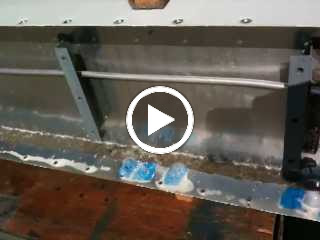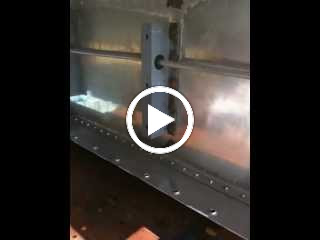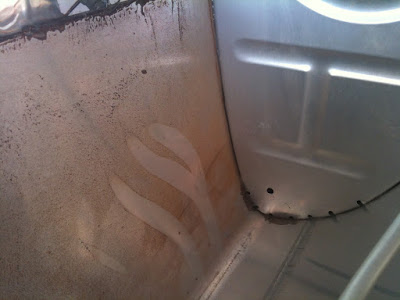RVbySDI
Well Known Member
I hope this post may be of use to those out there struggling like I am with a leaky fuel tank. I have a few pics and videos to show concerning my process along with a question concerning something I found in my fuel tank that I would like to understand.
I have been fighting fumes in the cockpit pretty much since my first flight. I have approximately 150 hours on my 9A now. I have always had a distinct smell of fuel whenever I would initially open the canopy prior to flight. The fumes have always dissipated on the ground once the engine was started. I attributed this to the air movement through the cockpit once the prop was spinning. I have never smelled fuel at any time during flight, only on the ground prior to engine start. Up until just a couple of months ago I had never seen any visual indications of a fuel leak, only a smell of fuel when I initially opened the canopy. However, back in November after fueling up one day I knelt down to take a look underneath the wing to see if there was any indication of fuel anywhere. There it was. There was a line of blue dye along the trailing edge of the fuel tank running from the fuselage outboard to the first inspection plate.
Well that was it. I grounded the plane in December. Over the Christmas/New Year holidays I pulled the left fuel tank off to see if I could fix the leak. I will not go through the process involved in pulling the fuel tank except to say that even though it does take a couple of hours of physical contortion to get back into the back side of the wing spar to remove 21 bolts and, every time I do this, the process does take some skin off of my hand, wrist and forearm, overall the process is doable.
At any rate, to shorten this post, I removed the tank in December and did the typical soapy water bubble test only to find . . . NOTHING! I pressurized the tank for days with a balloon that pretty much held its pressure. I was never able to see any bubbles form with the soapy water. I did see where there were some blue dye stains so I took some ProSeal to that section of the tank along the rear baffle seam and along one of the Z-brackets. I let it cure for a week and pressurized it again. It appeared there were no leaks. So, I put the tank back on.
I pressurized the tank for days with a balloon that pretty much held its pressure. I was never able to see any bubbles form with the soapy water. I did see where there were some blue dye stains so I took some ProSeal to that section of the tank along the rear baffle seam and along one of the Z-brackets. I let it cure for a week and pressurized it again. It appeared there were no leaks. So, I put the tank back on.
I am sure you know what happened next. After 3 or 4 flights I looked again underneath the wing. Yep! There was the blue dye again. Only this time it was worse! So, this weekend, off came the tank again. Again, I put the balloon on the tank, sealed it up and pressurized it. Only this time around the soapy water revealed multiple pin hole leaks along the bottom rear baffle seam. I took some pictures along with a couple of videos of my process.
There was the blue dye again. Only this time it was worse! So, this weekend, off came the tank again. Again, I put the balloon on the tank, sealed it up and pressurized it. Only this time around the soapy water revealed multiple pin hole leaks along the bottom rear baffle seam. I took some pictures along with a couple of videos of my process.
Click on the picture below to see the first video of the leaks along the bottom rear baffle seam:

After some deliberations I decided I could take the end plate off of the tank and with a long screwdriver reach through one of the rib baffle holes and get to the inside of the seam with some ProSeal. In the video above you also saw a leak in the far outboard corner of the rear baffle. I was able to reach down through the fuel filler opening to get to the inside of that seam.
Click on this picture to see the other video showing the inside of the tank after the access plate was removed.

So, if you watched the video you noticed the question I had. I noticed some fine powdery type residue on the inside of the fuel tank. The pictures do not really show all of the inside of the tank but it did look like the residue was mostly on the floor of the tank. From what I could tell, especially when I look closely at this picture it looks like this residue is from the ProSeal:

You can clearly see where the ProSeal on the reinforcing stringer on the floor of the tank is flowing outward from that seam.
[ed. 2/23/12, just in case you may not read all the way to the end of this thread I have discovered this residue is rust from my steal fuel storage tank I use for my 100LL fuel source. RVbySDI]
So the questions I have for everyone: Has anyone seen this before? Should I be concerned with it affecting the fuel as it flows into the engine? I would guess the filter(s) will catch most of it. Any thoughts at all would be appreciated.
I have the fuel tank sitting in my living room floor now in front of the fireplace. It will take several days for the ProSeal to cure. After that I will seal the access plate up and pressurize the tank again. We will see if my patch worked or if I missed. I was having to go more by feel than sight especially when I had to reach through the small baffle hole in the first rib. It is completely possible I could have missed sealing that section of the rear baffle seam. Once it cures and I can test it again I will have a better feel for whether I will have to reach into any of these areas from the inside again or not. Time will tell.
Click on https://picasaweb.google.com/114083177287781041474/FuelTankRepairs?authkey=Gv1sRgCILc6YSAxIOlMA to see all of the videos and pics I took while working on this repair.
I have been fighting fumes in the cockpit pretty much since my first flight. I have approximately 150 hours on my 9A now. I have always had a distinct smell of fuel whenever I would initially open the canopy prior to flight. The fumes have always dissipated on the ground once the engine was started. I attributed this to the air movement through the cockpit once the prop was spinning. I have never smelled fuel at any time during flight, only on the ground prior to engine start. Up until just a couple of months ago I had never seen any visual indications of a fuel leak, only a smell of fuel when I initially opened the canopy. However, back in November after fueling up one day I knelt down to take a look underneath the wing to see if there was any indication of fuel anywhere. There it was. There was a line of blue dye along the trailing edge of the fuel tank running from the fuselage outboard to the first inspection plate.
Well that was it. I grounded the plane in December. Over the Christmas/New Year holidays I pulled the left fuel tank off to see if I could fix the leak. I will not go through the process involved in pulling the fuel tank except to say that even though it does take a couple of hours of physical contortion to get back into the back side of the wing spar to remove 21 bolts and, every time I do this, the process does take some skin off of my hand, wrist and forearm, overall the process is doable.
At any rate, to shorten this post, I removed the tank in December and did the typical soapy water bubble test only to find . . . NOTHING!
I am sure you know what happened next. After 3 or 4 flights I looked again underneath the wing. Yep!
Click on the picture below to see the first video of the leaks along the bottom rear baffle seam:

After some deliberations I decided I could take the end plate off of the tank and with a long screwdriver reach through one of the rib baffle holes and get to the inside of the seam with some ProSeal. In the video above you also saw a leak in the far outboard corner of the rear baffle. I was able to reach down through the fuel filler opening to get to the inside of that seam.
Click on this picture to see the other video showing the inside of the tank after the access plate was removed.

So, if you watched the video you noticed the question I had. I noticed some fine powdery type residue on the inside of the fuel tank. The pictures do not really show all of the inside of the tank but it did look like the residue was mostly on the floor of the tank. From what I could tell, especially when I look closely at this picture it looks like this residue is from the ProSeal:
You can clearly see where the ProSeal on the reinforcing stringer on the floor of the tank is flowing outward from that seam.
[ed. 2/23/12, just in case you may not read all the way to the end of this thread I have discovered this residue is rust from my steal fuel storage tank I use for my 100LL fuel source. RVbySDI]
So the questions I have for everyone: Has anyone seen this before? Should I be concerned with it affecting the fuel as it flows into the engine? I would guess the filter(s) will catch most of it. Any thoughts at all would be appreciated.
I have the fuel tank sitting in my living room floor now in front of the fireplace. It will take several days for the ProSeal to cure. After that I will seal the access plate up and pressurize the tank again. We will see if my patch worked or if I missed. I was having to go more by feel than sight especially when I had to reach through the small baffle hole in the first rib. It is completely possible I could have missed sealing that section of the rear baffle seam. Once it cures and I can test it again I will have a better feel for whether I will have to reach into any of these areas from the inside again or not. Time will tell.
Click on https://picasaweb.google.com/114083177287781041474/FuelTankRepairs?authkey=Gv1sRgCILc6YSAxIOlMA to see all of the videos and pics I took while working on this repair.
Last edited:




